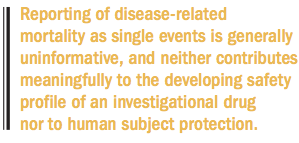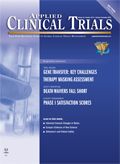Death Waivers an Incomplete Picture of Drug Safety
Applied Clinical Trials
Examining the practical significance of reporting patient deaths due to main disease progression.

The current practice of waiver on immediate reporting of cases of death due to the main disease progression may jeopardize data quality from discrepancies in the overall number of deaths registered and documented across the lifecycle reporting of a clinical trial. This article will describe the practical aspects of reporting deaths due to the main disease progression to ensure the data quality of the drug development program.
The International Conference on Harmonisation (ICH) E2A Guideline titled “Clinical Safety Data Management: Definitions and Standards for Expedited Reporting”1 defines a serious adverse event (or reaction) (SAE) as any untoward medical occurrence that at any dose results in death, is life-threatening, requires inpatient hospitalization or prolongation of existing hospitalization, results in persistent or significant disability/incapacity, or is a congenital anomaly/birth defect.
Serious adverse events are critically important for the identification of safety problems that might be significant enough to lead to important changes in the way the medicinal product is developed (e.g., change in dose, population, needed monitoring, consent forms). Such reactions should be expeditiously reported to regulatory authorities if they are suspected to be related to the medicinal product and unexpected as per the applicable product information.1
Reporting of death-an SAE in its most severe form-is the No. 1 postulate of drug safety or pharmacovigilance (PVG) as per ICH E2A. However, there are a number of trials in which death of the study subjects is an expected event and likely due to the main disease progression (e.g., late stage of cancer, coma). Reporting of disease-related mortality as single events is generally uninformative,

and neither contributes meaningfully to the developing safety profile of an investigational drug nor to human subject protection. Thus, the sponsor and regulatory authority rather frequently reach the agreement that such cases will be aggregated and compared to cases in a control group and submitted only if the event occurs more frequently in the drug treatment group.2 Many times, the study protocol or the investigator’s brochure identify cases of death due to the main disease progression as not requiring expedited reporting. Investigators will not complete and submit an SAE report form for such cases unless they are considered related to the study treatment by the investigator.3,4
On the other hand, at the end of the trial, the sponsor should summarize the study results in the clinical study report (CSR). The CSR is the document-above all other study information-that should include all comprehensive information of all SAEs (including all deaths) from each particular clinical trial and is reported to regulatory authorities by the study sponsor. In the ICH E3 Guideline for Industry titled “Structure and Content of Clinical Study Reports,”5 section 12.3.2 states that “there should be brief narratives describing each death, each other serious adverse event, and those of the other significant adverse events that are judged to be of special interest because of clinical importance.”
At this stage, if there was a waiver on expedited reporting of deaths due to the main disease progression, discrepancies may occur, such as:
- Death is an SAE in accordance with ICH E2A, and without any exception, information about all cases of death should be listed in the CSR (including cases of death that do not require immediate reporting as per the study protocol or the investigator’s brochure). However, not all cases of death have been captured in the safety database, as the cases of death due to the main disease progression were not reported within the trial expeditiously. We understand that our opponents may refer to the statement “Events (of death) that were clearly unrelated to the test drug/investigational product may be omitted or described very briefly” in section 12.3.2 of ICH E3. Nevertheless, the necessity to have all safety information on hand can arise at any stage of the investigational medicinal product life cycle based on analysis of aggregated data performed both for individual studies (if there are enough events to be informative) and across all studies.6 The larger sample size provides the best chance of detecting safety signals.7
- Comparison of disease-related mortality is performed during the interim and/or final analysis of statistical data derived from the clinical study database. In circumstances where the mortality rate in the study treatment group is higher than in the control group, the case would be considered a suspected unexpected serious adverse reaction (SUSAR) and investigational new drug (IND) safety reports should be prepared and submitted to regulatory authorities in narrative format for aggregated data in an expedited way. The individual cases that were analyzed should also be submitted at the same time (e.g., completed FDA Form 3500A for each case).2,6 However, as already discussed, not all cases of death were captured in the safety database if information about deaths due to the main disease progression were not collected within the trial.
It is the responsibility of the study sponsor to maintain the safety database in order to monitor the safety of medicinal products and to detect any change to their risk-benefit balance (including all events of death); however, information regarding deaths due to the main disease progression will not be comprehensively captured in the safety database. The lack of clarity and consistency in reporting of deaths in clinical trials can also lead to discordance in deaths documented across reports of a trial.8
As a contract research organization (CRO) and safety provider, we have already faced situations several times when it was very difficult to collect sufficient information about the cases of death due to the main disease progression that had not required the immediate reporting as per study protocol. Such information should be collected before the CSR finalization and sometimes after the study database lock (i.e., probably a long time after the occurrence). For queries, the investigators had to recall the information of patients who discontinued months (sometimes years) ago, which was rather time-consuming and annoying for the investigators.
From our point of view, the following steps are necessary to improve the process of cooperation between the different parties responsible for collection, evaluation, benefit/risk assessment, and regulatory reporting of deaths due to the main disease progression that are not reported by the investigator in an expedited way:
- Cross-functional operation procedure on collection of such occurrences within clinical trials should be developed by any CRO or the study sponsor (if they run clinical trials on their own).
- Safety management plan should match with, or contain a reference to, safety data reconciliation guidelines. Both documents should be finalized before the first patient in.
- Data management team should provide PVG team with the listings of deaths on a regular basis (e.g., monthly or quarterly). The PVG team should review the listings and reconcile them with previously reported SAE cases of death on an ongoing basis.
- Additional information should be requested from the clinical/site team for all cases of death that were not reported by the investigators on an expedited basis to avoid delayed queries after the end of the trial.
- Brief narratives are compiled for all cases of death either by the PVG team or by medical writers in accordance with the safety management plan.
Such simple steps can eliminate the possibility of losing data pertaining to disease-related mortality and could significantly improve the quality of CSRs and lifecycle documentation for the investigational product.
Because the regulations require reporting certain adverse events in the aggregate rather than as individual cases, it is important for sponsors to plan the process of collection and evaluation of such safety data in the very beginning of the investigational product life cycle. It is crucial to remember that brief narratives describing each death should be provided in CSRs and in IND safety reports in situations where the mortality rate in the study treatment group is higher than in the control group. For cases of death that are specifically defined in the protocol as the study endpoints, and that are neither collected in the safety database nor on the adverse event pages of the case report form, it also could be useful to design an additional case report form, so that the investigator could provide a brief narrative for the case in the pre-specified format.
A participant death is a serious event in a clinical trial and needs to be unambiguously reported either in IND or aggregated safety reports. Waiver on immediate reporting of cases of death due to the main disease progression can be a challenge in situations where the process of collection and evaluation of all cases of deaths was not carefully planned by the study sponsor in the very beginning of the investigational product life cycle. Failure to report all cases of death in the safety database leads to discrepancies in the number of deaths registered and documented across reports (the development safety update report, CSR) of a trial thereafter, affecting the quality of the reports. Incomplete reporting of deaths may overemphasize health benefits when benefits and harms of the investigational medicinal product are summarized in the large sample size or may influence the timelines of expedited reporting in circumstances where the mortality rate in the study treatment group is higher than in the control group.
References
1. International Conference on Harmonisation. “Clinical Safety Data Management: Definitions and Standards for Expedited Reporting.” E2A, Step 4. October 1994. http://www.ich.org/fileadmin/Public_Web_Site/ICH_Products/Guidelines/Efficacy/E2A/Step4/E2A_Guideline.pdf
2. United States Food and Drug Administration. “Final Rule: Investigational New Drug Safety Reporting Requirements for Human Drug and Biological Products and Safety Reporting Requirements for Bioavailability and Bioequivalence Studies in Humans.” 21 CFR Parts 312 and 320. October 2013. http://www.fda.gov/Drugs/DevelopmentApprovalProcess/HowDrugsareDevelopedandApproved/ApprovalApplications/InvestigationalNewDrugINDApplication/ucm226358.htm
3. European Parliament. “Approximation of the laws, regulations and administrative provisions of the Member States relating to the implementation of good clinical practice in the conduct of clinical trials on medicinal products for human use.” Directive 2001/20/EC. April 4, 2001. http://ec.europa.eu/health/files/eudralex/vol-1/dir_2001_20/dir_2001_20_en.pdf
4. European Commission. “Detailed guidance on the collection, verification and presentation of adverse event/reaction reports arising from clinical trials on medicinal products for human use (‘CT-3’).” 2011/C 172/01 Article 16(1). http://ec.europa.eu/health/files/eudralex/vol-10/2011_c172_01/2011_c172_01_en.pdf
5. International Conference on Harmonisation. “Structure and Content of Clinical Study Report.” E3, Step 4. November 1995. http://www.ich.org/fileadmin/Public_Web_Site/ICH_Products/Guidelines/Efficacy/E3/E3_Guideline.pdf
6. United States Department of Health and Human Services, Food and Drug Administration, Center for Drug Evaluation and Research (CDER), and Center for Biologics Evaluation and Research (CBER). “Guidance for Industry and Investigators: Safety Reporting Requirements for INDs and BA/BE studies.” December 2012. http://www.fda.gov/downloads/drugs/guidancecomplianceregulatoryinformation/guidances/ucm227351.pdf
7. International Conference on Harmonisation. “Statistical Principles for Clinical Trials.” E9, Step 4. February 1998. http://www.ich.org/fileadmin/Public_Web_Site/ICH_Products/Guidelines/Efficacy/E9/Step4/E9_Guideline.pdf
8. Earley Amy, Joseph Lau, and Katrin Uhlig. “Haphazard reporting of deaths in clinical trials: a review of cases of ClinicalTrials.gov records and matched publications–a cross-sectional study.” BMJ Open 2013;3:e001963. Accessed June 1, 2015. doi:10.1136/bmjopen-2012-001963.
Margarita Mare, MD, is Medical Officer/Pharmacovigilance Physician, PSI CRO South Africa (Pty) Ltd; Lisa Carlson is Director, Medical Writing, PSI Pharma Support America Inc.; Maxim Belotserkovskiy, MD, is Senior Director, Medical Affairs, PSI CRO Deutschland GmbH; Nickolai Usachev, MD, is Manager, Pharmacovigilance Unit, PSI Pharma Support Intl

Improving Relationships and Diversifying the Site Selection Process
April 17th 2025In this episode of the Applied Clinical Trials Podcast, Liz Beatty, co-founder and chief strategy officer, Inato, discusses a number of topics around site engagement including community-based sites, the role of technology in improving site/sponsor relationships, how increased operational costs are impacting the industry, and more.
Behind the Buzz: Why Clinical Research Leaders Flock to SCOPE Summit
February 7th 2025In this episode, we meet with Micah Lieberman, Executive Conference Director for SCOPE Summit (Summit for Clinical Ops Executives) at Cambridge Innovation Institute. We will dive deep into the critical role of collaboration within the clinical research ecosystem. How do we bring together diverse stakeholders—sponsors, CROs, clinical trial tech innovators, suppliers, patients, sites, advocacy organizations, investors, and non-profits—to share best practices in trial design, program planning, innovation, and clinical operations? We’ll explore why it’s vital for thought leaders to step beyond their own organizations and learn from others, exchanging ideas that drive advancements in clinical research. Additionally, we’ll discuss the pivotal role of scientific conferences like SCOPE Summit in fostering these essential connections and collaborations, helping shape the future of clinical trials. Join us as we uncover how collective wisdom and cross-industry partnerships are transforming the landscape of clinical research.
FDA-Approved Gene Therapy Beqvez Shows Sustained Efficacy, Safety in Long-Term Hemophilia B Trial
April 17th 2025Beqvez (fidanacogene elaparvovec), an FDA-approved one-time gene therapy for hemophilia B, demonstrated sustained factor IX expression, low bleeding rates, and a favorable safety profile over long-term follow-up.